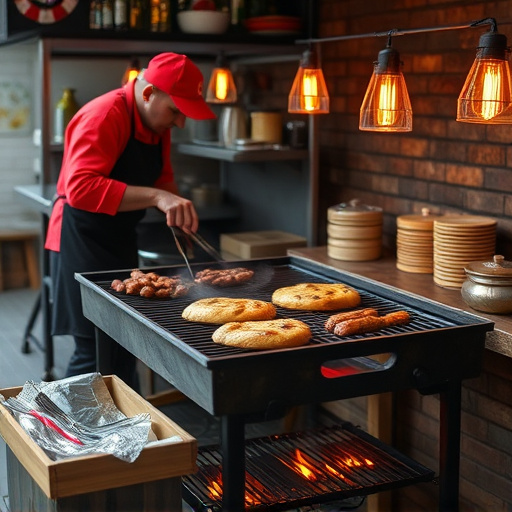Choosing the right cut of ribs (baby back or spare rib) with minimal fat is crucial for tenderness and flavor in a BBQ rib recipe. Use dry rubs, blending spices like chili powder, paprika, garlic, salt, pepper, brown sugar, thyme, and rosemary to enhance taste. Master cooking techniques: seal flavors with high heat (300-400°F / 150-200°C) and break down collagen with lower heat (225°F / 107°C) for 3-4 hours per pound. Select the perfect sauce (sweet, tangy, or spicy) based on personal preference to elevate flavor. Consider a two-step cooking process: smoke first for tenderness, then grill for a charred edge. Rest ribs post-cooking for 15-30 minutes to redistribute juices and achieve maximum tenderness. Serve with classic sides like coleslaw and cornbread at gatherings for a satisfying BBQ rib experience.
Unleash your inner BBQ guru with our ultimate guide to crafting mouthwatering ribs! Discover simple ingredients and techniques to elevate your grilling game. From choosing the perfect cut of ribs for tender goodness to mastering dry rubs, cooking science, sauce selection, and smoking techniques, we’ve got you covered. Learn why resting the ribs is crucial and explore delicious serving ideas. Uncover the secrets to a perfect BBQ rib recipe that’ll have folks lining up at your grill!
- Choosing the Right Cut of Ribs: A Key to Tenderness
- Dry Rubs: Seasoning Your Ribs for Maximum Flavor
- The Science Behind Cooking Ribs: Temperature and Time
- Sauces: Sweet, Tangy, or Spicy? Finding Your Perfect Match
- Smoking vs. Grilling: Techniques for BBQ Rib Mastery
- Resting the Ribs: Why This Step is Crucial for Juiciness
- Servings and Pairings: Completing the BBQ Rib Experience
Choosing the Right Cut of Ribs: A Key to Tenderness
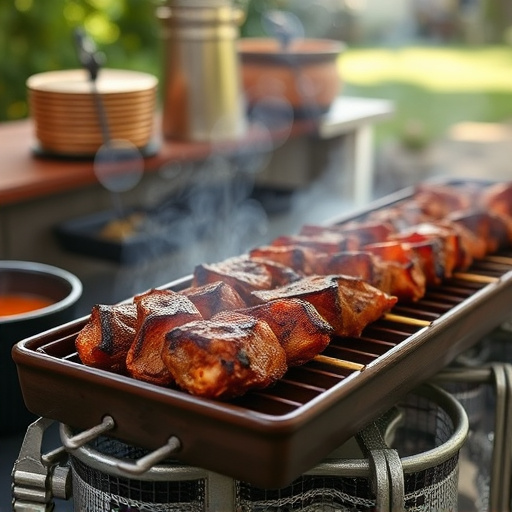
Choosing the right cut of ribs is a crucial step in achieving tender, mouthwatering barbecue ribs in any bbq rib recipe. Opting for baby back or spare rib cuts ensures a good balance between meat and bone structure. These cuts have less fat and more muscle, resulting in a juicier and more flavorful experience. When selecting your ribs, look for meaty pieces with minimal visible fat, as this can lead to a drier end product after cooking.
Focusing on quality and choosing the right cut will significantly impact the overall tenderness of your ribs. Proper preparation techniques, such as dry rubbing with spices or marinating, further enhance the flavor and ensure a satisfying barbecue rib recipe that’s sure to impress.
Dry Rubs: Seasoning Your Ribs for Maximum Flavor
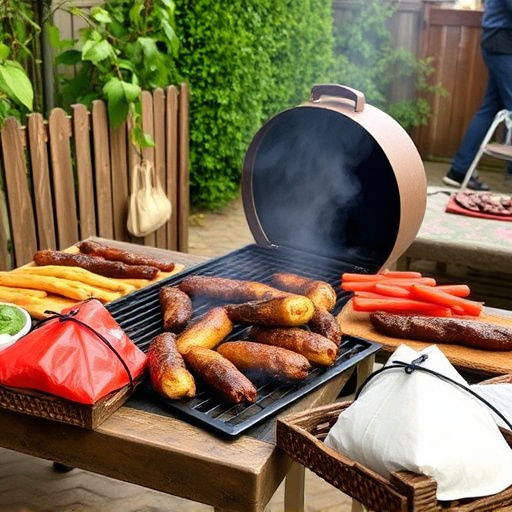
Dry rubs are a secret weapon in the world of BBQ ribs, offering a burst of flavor that can transform simple pork ribs into a mouthwatering delicacy. These seasonings are a blend of spices carefully curated to create a complex and tantalizing taste profile. When applied correctly, dry rubs enhance the natural juices and flavors within the meat, resulting in tender, juicy ribs with an unparalleled savory kick.
Creating your own dry rub allows for complete control over the ingredients and intensity of flavor. Common rub components include chili powder, paprika, garlic powder, salt, pepper, brown sugar, and various herbs like thyme or rosemary. The right combination can range from spicy to sweet, catering to diverse palates. For a delicious BBQ rib recipe, start by rubbing your ribs generously with this blend before slow-smoking them to perfection, ensuring each bite is an explosion of flavor.
The Science Behind Cooking Ribs: Temperature and Time
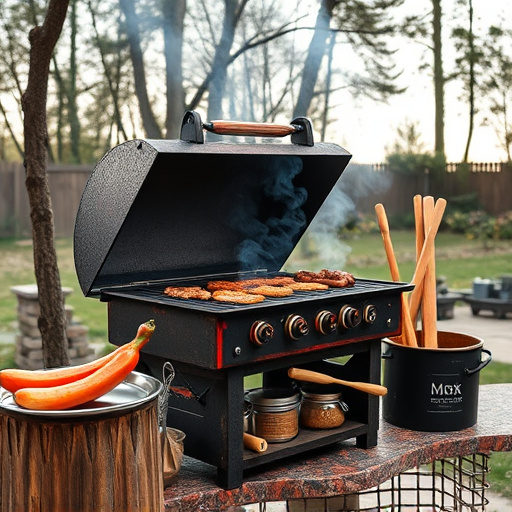
Cooking barbecue ribs is both an art and a science. Understanding the mechanics behind it, particularly temperature and time, is key to achieving that perfect tender, flavorful result. The process involves breaking down collagen in the rib meat through slow cooking at specific heat levels. High temperatures (around 300-400°F or 150-200°C) sear the exterior, locking in juices and flavors, while lower temperatures (typically around 225°F or 107°C) allow for gradual collagen breakdown. This transformation takes time—typically 3-4 hours per pound of ribs—as heat gently breaks down connective tissues, making the ribs tender enough to enjoy. Mastering these elements is essential in any bbq rib recipe, ensuring your ribs are not only tasty but also melt-in-your-mouth delicious.
Sauces: Sweet, Tangy, or Spicy? Finding Your Perfect Match
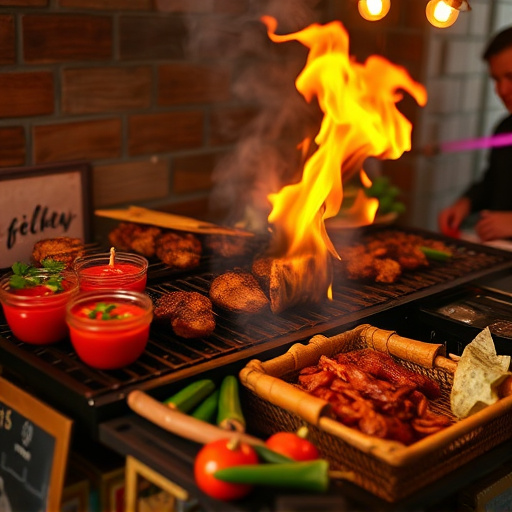
When it comes to barbecue ribs, the sauce is just as important as the cooking process itself. The sweet, tangy, or spicy varieties each offer a unique flavor profile that can elevate your ribs from good to great. Choosing the right sauce depends on personal taste and the desired level of heat. A classic sweet BBQ sauce adds a caramelized sweetness, balancing out the smoky flavors of the ribs. Tangy options, often featuring ingredients like vinegar or lemon juice, provide a refreshing bite that cuts through the richness of the meat. For those who enjoy a kick, spicy sauces incorporating chili peppers or paprika bring an intense heat that lingers deliciously on the palate.
Experimenting with different sauce types is key to finding your perfect match for any BBQ rib recipe. Some prefer a simple baste of sauce during the last few minutes of cooking for a glistening, flavorful finish. Others like to slather on a thick layer before smoking, allowing it to caramelize and form a sticky, delicious crust. Ultimately, the right sauce pairing can transform your ribs into a memorable culinary experience.
Smoking vs. Grilling: Techniques for BBQ Rib Mastery
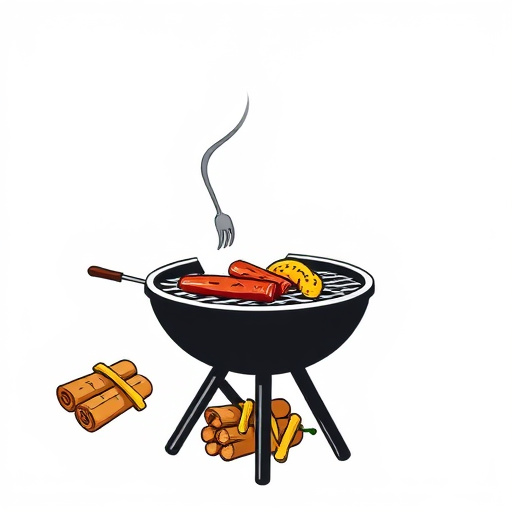
When it comes to crafting mouthwatering barbecue ribs, the debate between smoking and grilling often arises among enthusiasts. Both techniques have their merits, delivering unique flavors that elevate any bbq rib recipe. Smoking, characterized by slow, low-temperature cooking over wood chips or chunks, imparts a subtle, smoky taste and tenderizes the meat. This method is ideal for larger cuts of ribs, allowing them to cook evenly while retaining moisture.
Grilling, on the other hand, offers a faster approach with high heat, searing the surface and locking in juices. It creates distinctive grill marks and adds a smoky-sweet flavor from direct contact with the heat source. For best results, many chefs recommend a two-step process: smoking for several hours to achieve tender meat, followed by a quick grill session to enhance browning and add that coveted charred edge. This technique ensures ribs that are both incredibly juicy and packed with complex smoky aromas.
Resting the Ribs: Why This Step is Crucial for Juiciness
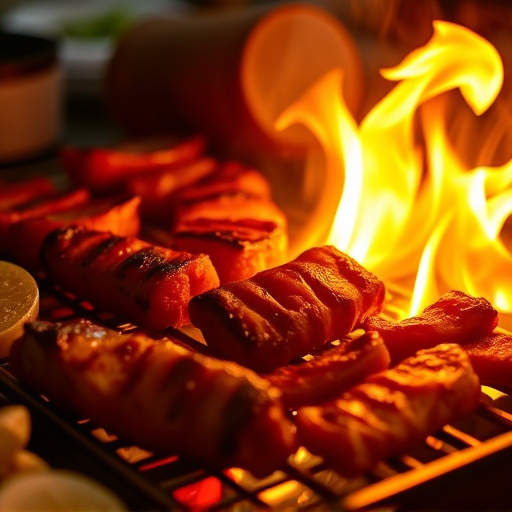
Resting the ribs after cooking is a crucial step in any bbq rib recipe. This resting period allows the juices to redistribute throughout the meat, ensuring each bite is juicy and tender. When meat is removed from direct heat, proteins contract, pushing moisture back into the interior. Skipping this step risks dry, tough ribs as the exterior can quickly overcook and squeeze out natural juices.
During rest, the internal temperature of the ribs continues to rise slightly, which further improves juiciness. This process allows enzymes to break down some of the collagen in the meat, making it even more tender. The resting time also gives your ribs a chance to develop a beautiful glaze from the barbecue sauce, enhancing both flavor and appearance.
Servings and Pairings: Completing the BBQ Rib Experience

When it comes to servings, a good BBQ rib recipe typically yields enough for 4-6 people, making it perfect for family gatherings or summer get-togethers with friends. To enhance the overall dining experience, pair your ribs with classic side dishes like coleslaw, baked beans, and cornbread. These sides not only complement the rich, smoky flavors of the ribs but also add texture and variety to your meal. For a refreshing contrast, offer a selection of cold beverages such as iced tea, lemonade, or a crisp beer, allowing your guests to customize their BBQ rib recipe enjoyment according to personal preferences.
